Fuel Tank Replacement Right w/Auto Trans
Removal Procedure
Caution: Provide additional support when a vehicle is on a hoist in the following
ways:
• Before removing parts, support the opposite end. This helps prevent
the vehicle from slipping off. • Before removing major components, chain the vehicle frame to the
hoist pads at the same end as the removal. This helps avoid a tip-off.
- Disconnect the negative battery cable.
- Relieve the fuel system pressure. Refer to the Fuel Pressure Relief .
- Drain the fuel tanks. Refer to Draining Fuel Tanks .
- Remove the mufflers. Refer to Muffler in Engine Exhaust.
- Disconnect the fuel sender electrical connector.
- Mark or identify each fuel pipe in order to aid in installing the pipes in their original positions.
- Disconnect the fuel sender fuel feed pipe (1) (jet pump to left tank) and the fuel feed rear crossover pipe (2) (left tank to jet pump) at the fuel sender. Refer to Servicing Quick Connect Fittings .
- Cap the fuel pipes in order to prevent possible fuel system contamination.
- Remove the tank crossover hose (3).
- Carefully disconnect the EVAP hose at the T-connector (2).
- Remove the fuel tank strap/shield.
- Remove the fuel tank.
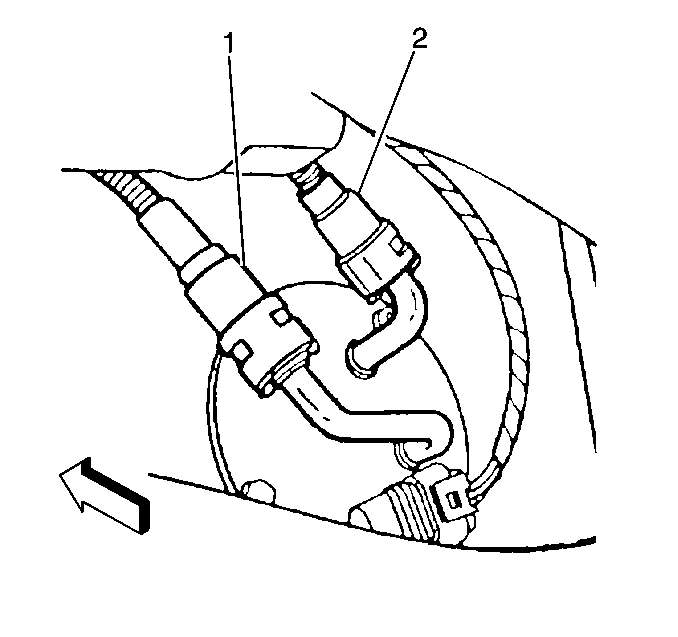
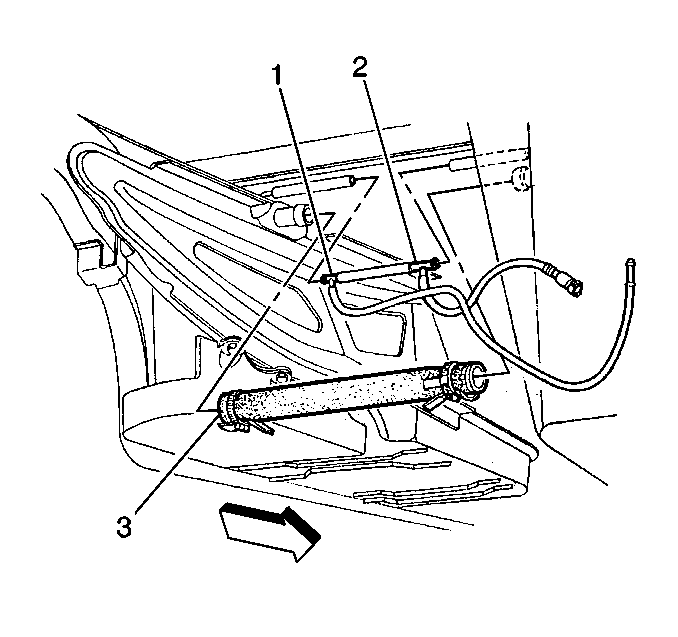
Important: Do not disconnect the EVAP hose at the roll over valve.
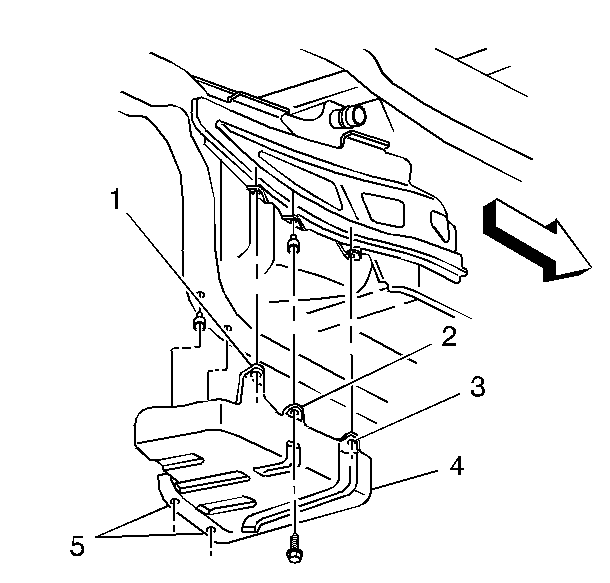
Installation Procedure
Important: Always replace the fuel system hose clamps with the original equipment or parts that meet the GM specifications for those parts when replacing the clamps.
- Install the fuel tank.
- Install the fuel tank strap/shield.
- Install the fuel tank strap/shield bolts.
- Connect the EVAP hose at the T-connector (2).
- Install the tank crossover hose (3).
- Push the clamps outboard against each fuel tank keeping the clamps parallel with the white stripes on the tank crossover hose.
- Remove the caps from the fuel pipes.
- Connect the fuel sender fuel feed pipe (1) (jet pump to left tank) and the fuel feed rear crossover pipe (2) (left tank to jet pump). Refer to Servicing Quick Connect Fittings .
- Connect the fuel sender electrical connector.
- Install the mufflers. Refer to Muffler in the Engine Exhaust section.
- Refill the fuel system.
- Connect the negative battery cable.
- Inspect for leaks.

Refer to the
Notice: Use the correct fastener in the correct location. Replacement fasteners must be the correct part number for that application. Fasteners requiring replacement or fasteners requiring the use of thread locking compound or sealant are identified in the service procedure. Do not use paints, lubricants, or corrosion inhibitors on fasteners or fastener joint surfaces unless specified. These coatings affect fastener torque and joint clamping force and may damage the fastener. Use the correct tightening sequence and specifications when installing fasteners in order to avoid damage to parts and systems.
in Cautions and Notices.| 3.1. | Install the net hole bolt (3). |
| 3.2. | Install the slot location bolt (1). |
| 3.3. | Install the remaining bolts (2 and 5). |
Tighten
Tighten the fuel tank strap/shield bolts to 25.5 N·m (19 lb ft).

Tighten
Tighten the tank crossover hose clamps to 4 N·m (35 lb in).

| 13.1. | Turn the ignition switch ON for 2 seconds. |
| 13.2. | Turn the ignition switch OFF for 10 seconds. |
| 13.3. | Turn the ignition switch ON. |
| 13.4. | Check for fuel leaks. |
Fuel Tank Replacement Left w/Auto Trans
Removal Procedure
Caution: Provide additional support when a vehicle is on a hoist in the following
ways:
• Before removing parts, support the opposite end. This helps prevent
the vehicle from slipping off. • Before removing major components, chain the vehicle frame to the
hoist pads at the same end as the removal. This helps avoid a tip-off.
- Disconnect the negative battery cable.
- Relieve the fuel system pressure. Refer to the Fuel Pressure Relief .
- Drain the fuel tanks. Refer to Draining Fuel Tanks .
- Remove the mufflers. Refer to Muffler in Engine Exhaust.
- Remove the left rear wheelhouse panel. Refer to Rear Wheelhouse Liner Panel in Body Rear End.
- Disconnect the fuel fill hose (3) and the vent hose (4).
- Disconnect the fuel system ground strap.
- Disconnect the fuel sender electrical connector.
- Mark or identify each fuel pipe in order to aid in installing the pipes in their original positions.
- Disconnect the fuel sender fuel feed pipe (1) (jet pump to left tank), the fuel return rear pipe (2), and the fuel feed rear pipe (3) at the fuel sender. Refer to Servicing Quick Connect Fittings .
- Cap the fuel pipes in order to prevent possible fuel system contamination.
- Remove the tank crossover hose (3).
- Carefully disconnect the EVAP hose at the T-connector (1).
- Remove the fuel tank strap/shield.
- Remove the fuel tank.
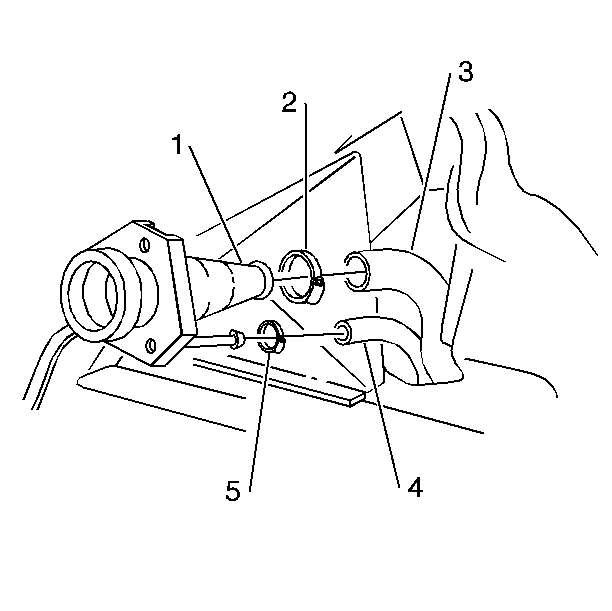
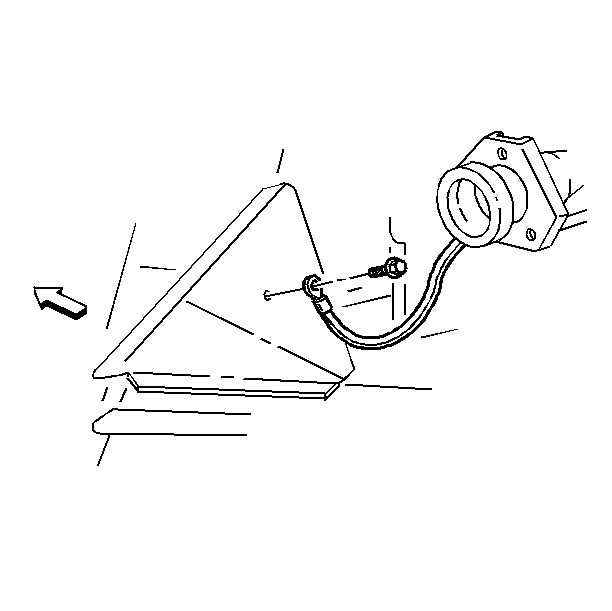
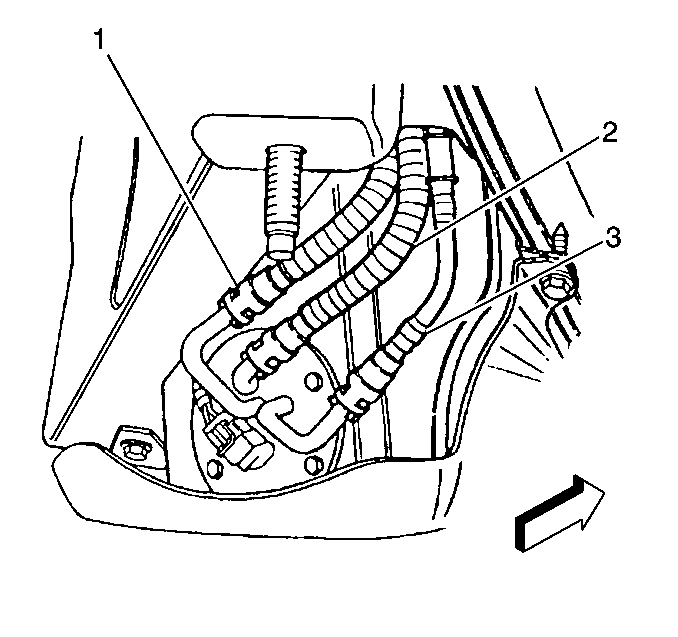

Important: Do not disconnect the EVAP hose at the roll over valve.

Installation Procedure
Important: Always replace the fuel system hose clamps with the original equipment or parts that meet the GM specifications for those parts when replacing the clamps.
- Install the fuel tank.
- Install the fuel tank strap/shield.
- Install the fuel tank strap/shield bolts.
- Connect the EVAP hose at the T-connector (1).
- Install the tank crossover hose (3).
- Push the clamps outboard against each fuel tank keeping the clamps parallel with the white stripes on the tank crossover hose.
- Remove the caps from the fuel pipes.
- Connect the fuel sender fuel feed pipe (1) (jet pump to left tank), the fuel return rear pipe (2), and the fuel feed rear pipe (3). Refer to Servicing Quick Connect Fittings .
- Connect the fuel sender electrical connector.
- Connect the fuel system ground strap.
- Connect the fuel fill hose (3) and the vent hose (4).
- Install the left rear wheelhouse liner panel. Refer to Rear Wheelhouse Liner Panel in the Body Rear End section.
- Install the mufflers. Refer to Muffler in the Engine Exhaust section.
- Refill the fuel system.
- Connect the negative battery cable.
- Inspect for leaks.

Refer to the
Notice: Use the correct fastener in the correct location. Replacement fasteners must be the correct part number for that application. Fasteners requiring replacement or fasteners requiring the use of thread locking compound or sealant are identified in the service procedure. Do not use paints, lubricants, or corrosion inhibitors on fasteners or fastener joint surfaces unless specified. These coatings affect fastener torque and joint clamping force and may damage the fastener. Use the correct tightening sequence and specifications when installing fasteners in order to avoid damage to parts and systems.
in Cautions and Notices.| 3.1. | Install the net hole location bolt (3). |
| 3.2. | Install the slot location bolt (1). |
| 3.3. | Install the remaining bolts (2 and 5). |
Tighten
Tighten the fuel tank strap/shield bolts to 25.5 N·m (19 lb ft).

Tighten
Tighten the tank crossover hose clamps to 4 N·m (35 lb in).


Tighten
Tighten the fuel system ground strap to 8 N·m (71 lb in).

Tighten
Tighten the fuel fill hose clamp and the vent hose clamp to 4 N·m
(35 lb in).
| 16.1. | Turn the ignition switch ON for 2 seconds. |
| 16.2. | Turn the ignition switch OFF for 10 seconds. |
| 16.3. | Turn the ignition switch ON. |
| 16.4. | Check for fuel leaks. |
Fuel Tank Replacement Right w/Manual Trans
Removal Procedure
Caution: Provide additional support when a vehicle is on a hoist in the following
ways:
• Before removing parts, support the opposite end. This helps prevent
the vehicle from slipping off. • Before removing major components, chain the vehicle frame to the
hoist pads at the same end as the removal. This helps avoid a tip-off.
- Disconnect the negative battery cable.
- Relieve the fuel system pressure. Refer to the Fuel Pressure Relief .
- Drain the fuel tanks. Refer to Draining Fuel Tanks .
- Disconnect the fuel sender electrical connector.
- Mark or identify each fuel pipe in order to aid in installing the pipes in their original positions.
- Disconnect the fuel sender fuel feed pipe (1) (jet pump to left tank) and the fuel feed rear crossover pipe (2) (left tank to jet pump) at the fuel sender. Refer to Servicing Quick Connect Fittings .
- Cap the fuel pipes in order to prevent possible fuel system contamination.
- Remove the tank crossover hose (3).
- Carefully disconnect the EVAP hose at the T-connector (2).
- Remove the fuel tank strap/shield.
- Remove the fuel tank.


Important: Do not disconnect the EVAP hose at the roll over valve.

Installation Procedure
Important: Always replace the fuel system hose clamps with the original equipment or parts that meet the GM specifications for those parts when replacing the clamps.
- Install the fuel tank.
- Install the fuel tank strap/shield.
- Install the fuel tank strap/shield bolts.
- Connect the EVAP hose at the T-connector (2).
- Install the tank crossover hose (3).
- Push the clamps outboard against each fuel tank keeping the clamps parallel with the white stripes on the tank crossover hose.
- Remove the caps from the fuel pipes.
- Connect the fuel sender fuel feed pipe (1) (jet pump to left tank) and the fuel feed rear crossover pipe (2) (left tank to jet pump). Refer to Servicing Quick Connect Fittings .
- Connect the fuel sender electrical connector.
- Refill the fuel system.
- Connect the negative battery cable.
- Inspect for leaks.

Refer to the
Notice: Use the correct fastener in the correct location. Replacement fasteners must be the correct part number for that application. Fasteners requiring replacement or fasteners requiring the use of thread locking compound or sealant are identified in the service procedure. Do not use paints, lubricants, or corrosion inhibitors on fasteners or fastener joint surfaces unless specified. These coatings affect fastener torque and joint clamping force and may damage the fastener. Use the correct tightening sequence and specifications when installing fasteners in order to avoid damage to parts and systems.
in Cautions and Notices.| 3.1. | Install the net hole bolt (3). |
| 3.2. | Install the slot location bolt (1). |
| 3.3. | Install the remaining bolts (2 and 5). |
Tighten
Tighten the fuel tank strap/shield bolts to 25.5 N·m (19 lb ft).

Tighten
Tighten the tank crossover hose clamps to 4 N·m (35 lb in).

| 12.1. | Turn the ignition switch ON for 2 seconds. |
| 12.2. | Turn the ignition switch OFF for 10 seconds. |
| 12.3. | Turn the ignition switch ON. |
| 12.4. | Check for fuel leaks. |
Fuel Tank Replacement Left w/Manual Trans
Removal Procedure
Caution: Provide additional support when a vehicle is on a hoist in the following
ways:
• Before removing parts, support the opposite end. This helps prevent
the vehicle from slipping off. • Before removing major components, chain the vehicle frame to the
hoist pads at the same end as the removal. This helps avoid a tip-off.
- Disconnect the negative battery cable.
- Relieve the fuel system pressure. Refer to the Fuel Pressure Relief .
- Drain the fuel tanks. Refer to Draining Fuel Tanks .
- Remove the left rear wheelhouse panel. Refer to Rear Wheelhouse Liner Panel in Body Rear End.
- Disconnect the fuel fill hose (3) and the vent hose (4).
- Disconnect the fuel system ground strap.
- Disconnect the fuel sender electrical connector.
- Mark or identify each fuel pipe in order to aid in installing the pipes in their original positions.
- Disconnect the fuel sender fuel feed pipe (1) (jet pump to left tank), the fuel return rear pipe (2), and the fuel feed rear pipe (3) at the fuel sender. Refer to Servicing Quick Connect Fittings .
- Cap the fuel pipes in order to prevent possible fuel system contamination.
- Remove the tank crossover hose (3).
- Carefully disconnect the EVAP hose at the T-connector (1).
- Remove the fuel tank strap/shield.
- Remove the fuel tank.




Important: Do not disconnect the EVAP hose at the roll over valve.

Installation Procedure
Important: Always replace the fuel system hose clamps with the original equipment or parts that meet the GM specifications for those parts when replacing the clamps.
- Install the fuel tank.
- Install the fuel tank strap/shield.
- Install the fuel tank strap/shield bolts.
- Connect the EVAP hose at the T-connector (1).
- Install the tank crossover hose (3).
- Push the clamps outboard against each fuel tank keeping the clamps parallel with the white stripes on the tank crossover hose.
- Remove the caps from the fuel pipes.
- Connect the fuel sender fuel feed pipe (1) (jet pump to left tank), the fuel return rear pipe (2), and the fuel feed rear pipe (3). Refer to Servicing Quick Connect Fittings .
- Connect the fuel sender electrical connector.
- Connect the fuel system ground strap.
- Connect the fuel fill hose (3) and the vent hose (4).
- Install the left rear wheelhouse liner panel. Refer to Rear Wheelhouse Liner Panel in the Body Rear End section.
- Refill the fuel system.
- Connect the negative battery cable.
- Inspect for leaks.

Refer to the
Notice: Use the correct fastener in the correct location. Replacement fasteners must be the correct part number for that application. Fasteners requiring replacement or fasteners requiring the use of thread locking compound or sealant are identified in the service procedure. Do not use paints, lubricants, or corrosion inhibitors on fasteners or fastener joint surfaces unless specified. These coatings affect fastener torque and joint clamping force and may damage the fastener. Use the correct tightening sequence and specifications when installing fasteners in order to avoid damage to parts and systems.
in Cautions and Notices.| 3.1. | Install the net hole location bolt (3). |
| 3.2. | Install the slot location bolt (1). |
| 3.3. | Install the remaining bolts (2 and 5). |
Tighten
Tighten the fuel tank strap/shield bolts to 25.5 N·m (19 lb ft).

Tighten
Tighten the tank crossover hose clamps to 4 N·m (35 lb in).


Tighten
Tighten the fuel system ground strap to 8 N·m (71 lb in).

Tighten
Tighten the fuel fill hose clamp and the vent hose clamp to 4 N·m
(35 lb in).
| 15.1. | Turn the ignition switch ON for 2 seconds. |
| 15.2. | Turn the ignition switch OFF for 10 seconds. |
| 15.3. | Turn the ignition switch ON. |
| 15.4. | Check for fuel leaks. |
